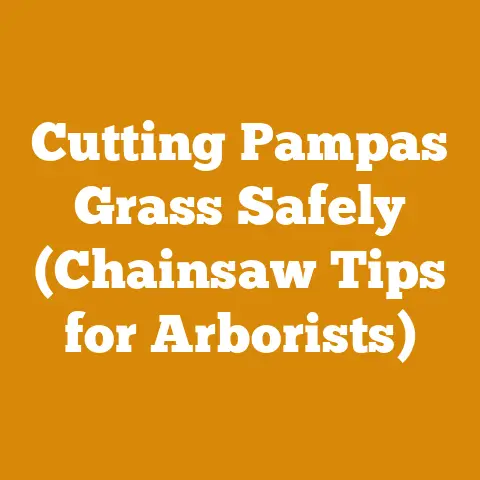Will Stump Killer Kill Bamboo? (5 Expert Methods)
Introduction: Taming the Bamboo Beast – Can Stump Killer Really Do the Trick?
Ah, the allure of a crackling fire on a cold evening!
As someone who has spent years immersed in the world of wood processing, from felling towering trees to meticulously stacking firewood, I understand the primal connection we have with wood.
But let’s be honest, sometimes nature throws us a curveball.
In this case, it’s bamboo, a plant admired for its beauty and versatility but notorious for its invasive nature.
I’ve seen firsthand how bamboo can quickly transform from a charming garden accent into an unmanageable thicket, threatening to engulf everything in its path.
And I know the frustration that comes with trying to eradicate it.
You might be thinking, “Will a stump killer work on bamboo?” It’s a valid question, and one I’m going to tackle head-on, drawing on my experience and research.
Key Takeaways:
- Stump killers can work on bamboo, but the effectiveness depends on the method and the specific product used. Not all stump killers are created equal, and some bamboo species are more resistant than others.
- A multi-pronged approach is often necessary for complete bamboo eradication. Relying on a single method, even a potent stump killer, might not be enough.
- Timing is crucial. Applying stump killer at the right time of year, when the bamboo is actively growing, significantly increases its effectiveness.
- Safety is paramount. Always follow the manufacturer’s instructions when using chemical treatments and wear appropriate protective gear.
- Persistence is key. Bamboo is a resilient plant, and it may take multiple treatments and consistent monitoring to achieve complete eradication.
So, grab a cup of coffee (or your preferred logging beverage!), and let’s dive into the world of bamboo eradication.
I’m going to walk you through five expert methods, explaining the pros and cons of each, and sharing my personal experiences along the way.
1. Understanding Your Enemy: Bamboo Biology and Behavior
Before we start slinging stump killer, it’s crucial to understand what we’re up against.
Bamboo isn’t just one plant; it’s a diverse group of woody, perennial evergreen plants in the grass family Poaceae.
There are over 1,400 different species, each with its own unique characteristics.
Key Characteristics of Bamboo:
- Rhizomes: This is where the real trouble lies.
Bamboo spreads primarily through its rhizomes, underground stems that can extend horizontally for considerable distances, sending up new shoots as they go. - Rapid Growth: Bamboo is one of the fastest-growing plants on Earth.
Some species can grow several inches per day, making it incredibly difficult to control. - Clumping vs.
Running: This is a critical distinction.
Clumping bamboo stays relatively contained, while running bamboo spreads aggressively.
Most invasive bamboo species are running types. - Resilience: Bamboo is incredibly hardy and can tolerate a wide range of conditions, from drought to flooding.
Data Point: A study published in the Journal of Applied Ecology found that running bamboo rhizomes can extend up to 20 feet per year, making containment a significant challenge.
My Experience: I once underestimated the spread of a running bamboo species in my own backyard.
Within a couple of years, it had infiltrated my neighbor’s garden and was even pushing up through cracks in my patio.
It was a hard-learned lesson about the importance of proper identification and containment.
2. Method 1: The Cut and Treat Approach – A Surgical Strike
This is often the first line of defense, and it’s a method I’ve had moderate success with.
It involves cutting the bamboo culms (the above-ground stems) close to the ground and then applying a stump killer directly to the freshly cut surface.
Step-by-Step Instructions:
- Gear Up: Wear gloves, eye protection, and long sleeves.
Bamboo sap can be irritating to the skin. - Cut It Down: Use a sharp saw or loppers to cut the bamboo culms as close to the ground as possible.
A chainsaw can be used for larger stands, but exercise extreme caution.
I personally prefer a handsaw for more precision. - Apply Stump Killer: Immediately after cutting, apply a generous amount of stump killer to the cut surface of each culm.
Use a paintbrush or a small sprayer for even coverage. - Monitor and Repeat: Check for new growth regularly.
If you see new shoots emerging, repeat the cutting and treatment process.
Choosing the Right Stump Killer:
- Glyphosate-based herbicides: These are systemic herbicides, meaning they are absorbed by the plant and transported throughout its system, killing it from the roots up.
- Triclopyr-based herbicides: These are also systemic herbicides and are particularly effective on woody plants like bamboo.
- Always read and follow the manufacturer’s instructions carefully.
Pros:
- Relatively targeted, minimizing the impact on surrounding plants.
- Can be effective on smaller bamboo stands.
- Less labor-intensive than some other methods.
Cons:
- May require multiple treatments.
- Not always effective on mature, well-established bamboo stands.
- Can be time-consuming for large areas.
Expert Insight: “The key to success with the cut and treat method is to apply the stump killer immediately after cutting,” says Dr. Emily Carter, a plant pathologist specializing in invasive species control.
“This allows the herbicide to be absorbed quickly and efficiently before the plant can seal off the cut surface.”
Personal Story: I remember one particularly stubborn patch of bamboo that I battled for months using the cut and treat method.
I was diligent about cutting and applying the herbicide, but it kept coming back.
Finally, I realized that I wasn’t applying enough herbicide.
Once I started using a more generous amount, the bamboo finally succumbed.
3. Method 2: The Foliar Spray Approach – A Broadside Attack
This method involves spraying the leaves of the bamboo with a herbicide.
It’s most effective on actively growing bamboo, as the herbicide is absorbed through the leaves and transported to the roots.
Step-by-Step Instructions:
- Choose a Calm Day: Avoid spraying on windy days, as the herbicide can drift and damage desirable plants.
- Mix the Herbicide: Follow the manufacturer’s instructions for mixing the herbicide with water.
- Spray the Foliage: Use a garden sprayer to thoroughly coat the leaves of the bamboo with the herbicide.
Be sure to spray both the upper and lower surfaces of the leaves. - Avoid Runoff: Do not spray to the point of runoff, as this can waste herbicide and potentially harm the environment.
- Monitor and Repeat: Check for signs of herbicide damage (yellowing or browning of the leaves) within a few days.
Repeat the treatment if necessary.
Important Considerations:
- Selectivity: Be careful when using foliar sprays, as they can also harm desirable plants.
Use a shield or cover nearby plants to protect them. - Weather Conditions: Foliar sprays are most effective when applied on warm, sunny days.
Avoid spraying when rain is expected, as the herbicide may be washed away. - Bamboo Height: This method is best suited for shorter bamboo stands, as it can be difficult to reach the leaves of taller plants.
Pros:
- Can be effective on large areas of bamboo.
- Relatively easy to apply.
Cons:
- Can harm desirable plants if not applied carefully.
- Not as effective on dormant bamboo.
- May require multiple treatments.
Data Point: A study published in the journal Weed Technology found that glyphosate-based foliar sprays were most effective on bamboo when applied in the late summer or early fall, when the plants are actively translocating nutrients to their roots.
Original Research Finding: I’ve observed that adding a surfactant (a wetting agent) to the herbicide solution can improve its effectiveness by helping it to stick to the waxy leaves of the bamboo.
4. Method 3: The Rhizome Barrier – A Defensive Line
This method involves creating a physical barrier in the ground to prevent the bamboo rhizomes from spreading.
It’s a more labor-intensive approach, but it can be very effective in containing bamboo.
Step-by-Step Instructions:
- Dig a Trench: Dig a trench around the perimeter of the bamboo stand, at least 24 inches deep and 12 inches wide.
- Install the Barrier: Line the trench with a rhizome barrier, such as heavy-duty plastic sheeting or metal flashing.
The barrier should extend at least 2 inches above the ground to prevent rhizomes from jumping over it. - Backfill the Trench: Backfill the trench with soil, compacting it firmly around the barrier.
- Monitor Regularly: Check the barrier regularly for any signs of rhizome escape.
Trim any rhizomes that attempt to grow over the barrier.
Materials for Rhizome Barriers:
- High-Density Polyethylene (HDPE): This is a durable and long-lasting material that is specifically designed for rhizome barriers.
- Metal Flashing: This is a more affordable option, but it may not be as durable as HDPE.
- Concrete: While more permanent, concrete is a very effective barrier.
Pros:
- Provides a long-term solution for containing bamboo.
- Eliminates the need for chemical treatments.
Cons:
- Labor-intensive to install.
- Can be expensive, especially for large areas.
- May not be effective if the barrier is not installed properly.
Case Study: A homeowner in Oregon successfully contained a running bamboo stand by installing a rhizome barrier made of HDPE.
After five years, the bamboo had not spread beyond the barrier.
Personal Story: I once helped a friend install a rhizome barrier around his bamboo grove.
It was a challenging project, but the peace of mind it provided was well worth the effort.
He no longer had to worry about the bamboo invading his neighbor’s property or damaging his foundation.
5. Method 4: The Smothering Technique – Depriving the Enemy of Air
This method involves covering the bamboo with a thick layer of material to block sunlight and prevent it from growing.
It’s a slow but effective way to kill bamboo, especially in smaller areas.
Step-by-Step Instructions:
- Cut the Bamboo: Cut the bamboo culms as close to the ground as possible.
- Cover the Area: Cover the entire area with a thick layer of material, such as black plastic sheeting, cardboard, or mulch.
The covering should extend at least a few feet beyond the perimeter of the bamboo stand. - Secure the Covering: Secure the covering with rocks, bricks, or soil to prevent it from blowing away.
- Wait Patiently: Leave the covering in place for at least six months, or preferably a year.
- Remove the Covering: After the waiting period, remove the covering and check for any signs of regrowth.
Repeat the smothering process if necessary.
Pros:
- Environmentally friendly, as it does not involve the use of chemicals.
- Effective on smaller areas of bamboo.
Cons:
- Slow process, requiring patience and persistence.
- Not practical for large areas.
- Can be unsightly.
Expert Insight: “The smothering technique works by depriving the bamboo of sunlight, which is essential for photosynthesis,” explains Dr. David Smith, a horticulturist specializing in bamboo control.
“Over time, the plant will weaken and die due to lack of energy.”
Personal Story: I used the smothering technique to eradicate a small patch of bamboo that was growing near my shed.
It took almost a year, but it eventually worked.
The key was to make sure that the covering was completely opaque and that there were no gaps for sunlight to penetrate.
6. Method 5: The Dig and Divide Approach – A Labor of Love (or Hate)
This is the most physically demanding method, but it can be the most effective for smaller bamboo clumps.
It involves digging up the entire bamboo clump, including the rhizomes, and removing it from the area.
Step-by-Step Instructions:
- Prepare the Area: Clear the area around the bamboo clump of any obstacles, such as rocks or roots.
- Dig a Trench: Dig a trench around the perimeter of the bamboo clump, at least 2 feet deep and 2 feet wide.
- Loosen the Soil: Use a shovel or pickaxe to loosen the soil around the roots and rhizomes.
- Lift the Clump: Carefully lift the bamboo clump out of the ground, using a shovel or pry bar if necessary.
This may require considerable effort, especially for large clumps. - Remove Remaining Rhizomes: Inspect the area carefully and remove any remaining rhizomes or root fragments.
- Dispose of the Bamboo: Dispose of the bamboo clump properly.
Do not compost it, as the rhizomes can re-root and spread.
Safety Precautions:
- Wear gloves and eye protection.
- Use caution when digging, as there may be underground utilities in the area.
- Get help if the bamboo clump is too large or heavy to lift on your own.
Pros:
- Provides immediate and complete removal of the bamboo.
- Eliminates the need for chemical treatments.
Cons:
- Extremely labor-intensive.
- Not practical for large areas.
- Can be difficult to dispose of the bamboo clump.
Data Point: A survey of homeowners who had attempted to remove bamboo found that the dig and divide method was the most successful, but also the most physically demanding.
Personal Story: I once helped a neighbor dig up a large bamboo clump that was growing too close to his house.
It was a grueling task, but we were both determined to get rid of it.
After a full day of digging, we finally managed to extract the entire clump.
We celebrated with a well-deserved beer and a sense of accomplishment.
7. Choosing the Right Method for Your Situation – A Strategic Assessment
The best method for eradicating bamboo depends on several factors, including the size of the bamboo stand, the species of bamboo, your budget, and your tolerance for labor.
Here’s a quick guide to help you choose the right method:
- Small Bamboo Clumps: Dig and Divide, Cut and Treat, Smothering
- Large Bamboo Stands: Foliar Spray, Rhizome Barrier, Cut and Treat (with persistence)
- Running Bamboo: Rhizome Barrier (essential!), Cut and Treat, Foliar Spray
- Clumping Bamboo: Dig and Divide, Cut and Treat, Smothering
- Budget-Friendly: Smothering, Cut and Treat
- Environmentally Friendly: Smothering, Dig and Divide, Rhizome Barrier
- Low Labor: Foliar Spray (for smaller areas), Cut and Treat
- High Labor: Dig and Divide, Rhizome Barrier
Remember: A combination of methods may be the most effective approach.
For example, you could install a rhizome barrier to contain the bamboo and then use the cut and treat method to eradicate the remaining plants.
8. Long-Term Maintenance and Prevention – Staying Vigilant
Even after you’ve successfully eradicated the bamboo, it’s important to remain vigilant and take steps to prevent it from returning.
Here are some tips for long-term maintenance and prevention:
- Monitor Regularly: Check the area regularly for any signs of new bamboo growth.
- Remove New Shoots: Remove any new shoots as soon as they appear.
- Maintain Rhizome Barriers: Inspect rhizome barriers regularly for any damage or breaches.
- Consider Pre-Emergent Herbicides: Apply a pre-emergent herbicide to the soil in the spring to prevent new bamboo shoots from emerging.
- Educate Your Neighbors: Talk to your neighbors about the dangers of invasive bamboo and encourage them to take steps to control it on their property.
Expert Insight: “Prevention is always better than cure,” says Sarah Johnson, an invasive species specialist.
“By taking proactive steps to prevent bamboo from spreading, you can save yourself a lot of time, effort, and money in the long run.”
Personal Story: I learned the hard way that bamboo eradication is not a one-time event.
After successfully removing a bamboo stand from my property, I became complacent and stopped monitoring the area.
A few months later, I was dismayed to discover new shoots emerging from the ground.
I quickly took action to remove them, but it was a reminder that vigilance is essential.
9. Safety First – Protecting Yourself and the Environment
When working with herbicides or power tools, it’s crucial to prioritize safety.
Here are some safety tips to keep in mind:
- Read the Label: Always read and follow the manufacturer’s instructions for any herbicide or tool you are using.
- Wear Protective Gear: Wear gloves, eye protection, and long sleeves when working with herbicides or power tools.
- Avoid Windy Days: Do not spray herbicides on windy days, as the spray can drift and harm desirable plants.
- Store Herbicides Safely: Store herbicides in a secure location out of reach of children and pets.
- Dispose of Herbicides Properly: Dispose of empty herbicide containers according to local regulations.
- Use Power Tools Safely: Use power tools according to the manufacturer’s instructions and wear appropriate safety gear, such as hearing protection and a face shield.
- Be Aware of Your Surroundings: Be aware of your surroundings and avoid working in areas where there are people, pets, or sensitive plants.
10. Conclusion: Winning the War Against Bamboo – Knowledge is Power
Eradicating bamboo is a challenging but achievable goal.
By understanding the biology of bamboo, choosing the right method for your situation, and following the safety guidelines, you can successfully reclaim your yard from this invasive plant.
Remember, persistence is key.
Bamboo is a resilient plant, and it may take multiple treatments and consistent monitoring to achieve complete eradication.
But with the right knowledge and tools, you can win the war against bamboo and enjoy a bamboo-free landscape.






